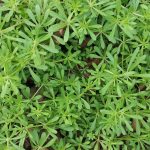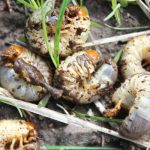Plant Diseases
Get the cure for common plant diseases.

Diseases can crop up during both the wet and hot, dry seasons. Learn which diseases are the most serious and how to minimize them.
What’s Happening
We lose many plants to root rot during extremely wet seasons. The plant roots are damaged by staying wet over long periods. They sometimes don’t show the damage until hot weather causes stress, and the roots can no longer support the plant.
Threat Level
Serious after it gets started. When it is wet outside, an ounce of prevention is worth much more than a pound of cure.
| TREATMENT | CATEGORY | EFFECTIVENESS | NOTES |
|---|---|---|---|
| Pull Back Mulch in Rainy Periods | Cultural Practice | High | This is confusing. Mulch is good, but should be pulled back? Sometimes too much moisture on a plant that needs drainage can result in rot. Examples of susceptible plants are: Iris, Mountain Laurel, Cactus and Herbs. |
| Trim Back Dead Plant Material in Rainy Periods | Cultural Practice | High | Dead leaves and dead foliage hold in a lot of moisture. If you smell rotting and it has been wet, pull back leaf matter and dead foliage to increase air flow. |
| Good Planting Technique | Cultural Practice | High | All new plants should be planted in native soil that can drain when the hole is filled with water. Never plant beyond the depth of the container your plant came in. Leave mulch back away from the trunk of shrubs and trees. |
What’s Happening
A fungal plant disease that causes rapid death of otherwise healthy plants during hot summer months. It is found in the soil and destroys root systems on susceptible plants. Look for a white, cotton-like substance on roots of plants that have died very quickly.
Threat Level
High for single plant. Once you figure out this might be a problem in one spot of your yard, the plant in question is dead. It is not likely to kill more plants over a wide area.
Treatment
You may use Agricultural Sulfur to treat the disease however, not particularly effective. It is recommended to replace plant with resistant variety. Check with plantanswers.com for a list. Amend the soil in the area with plenty of compost. This may help new, resistant plants survive.
What’s Happening
Leaves have irregular black spots and turn yellow as they drop from the plant.
Threat Level
Low with just a few spots. It can be a sign of needing to change garden practices.
| TREATMENT | CATEGORY | EFFECTIVENESS | NOTES |
|---|---|---|---|
| Avoid Wet Foliage at Night | Cultural Practice | Good Prevention | Wet foliage, especially during cooler nights, is great breeding grounds for fungal disease. |
| Prune Back Foliage | Cultural Practice | Good Prevention in Early Stage | If an area of the garden seems to be chronically wet and fungal leaf spot is beginning to develop, then prune back to increase airflow. |
| Resistant Plants | Cultural Practice | Good Prevention | Certain plants like Red Tip Photinia are particularly susceptible to disease. If a plant is doing very poorly, the long-term solution may be to replace it with a resistant choice. |
Related Video

Related Article






